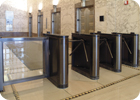
Traditional turnstiles, around for years, hinder
access but need a security officer or security video to add higher level
control
The purpose of most access control systems is to allow authorized individuals entry into secured facilities while denying or limiting access to unauthorized individuals. Most access control systems, whether large or small, sophisticated or simple, do this by restricting or enabling the unlocking of entrance doors
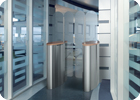
Some optical turnstiles detect tailgating but
the addition of swinging arms and sliding glass panels helps, too.
Facility managers and security directors often establish workplace policies that require employees to verify the authorized status of tailgaters, but most people simply don’t want to turn around and confront who almost always turns out to be their fellow employees.
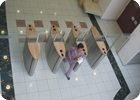
Some
optical turnstiles detect tailgating but the addition of swinging arms and
sliding glass panels helps, too
LOW SECURITY TURNSTILES
Rather than trying to get employees to play the role of security officer, facilities can use many different forms of security entrances that will effectively minimize or prevent tailgating and piggybacking. These different security entrances offer varying levels of security coupled with a diverse range of aesthetic appearances, providing multiple choices for the facility owner.The most commonly used security entrance is a turnstile. Traditional 3-arm waist high tripod-type turnstiles have been available for decades, and provide a reasonable means of hindering access to unauthorized individuals. They are compatible with all types of access control systems. Waist high turnstiles allow a security officer to monitor multiple lanes simultaneously for people attempting to step over or under without proper authorization. Many different cabinet styles and finishes are available to fit into almost any building décor.
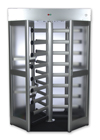
Barrier lanes gain from higher panels on the
units so that people cannot leap over them.
However, because optical turnstiles only detected tailgating, the need eventually arose to add some type of physical barrier to the units. This led manufacturers to incorporate various types of swinging arms and sliding glass panels to the optical turnstiles, creating what are often referred to as optical barrier lanes or optical portals.
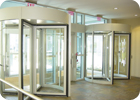
For maximum security, revolving portals and
doors can detect unauthorized entry but also fight tailgating and piggybacking
MEDIUM SECURITY TURNSTILES
While tripod turnstiles, optical turnstiles and optical barrier lanes can all detect or prevent tailgating and unauthorized entry to varying degrees, they are still only security “speed bumps” because of their low height.For greater security, optical barrier lane equipment can provide tall glass panels on their units, including on the tops of the cabinets, to make it even more difficult to step or leap over. This provides a further obstacle to someone trying to gain unauthorized entry into a facility.
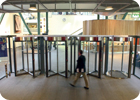
For maximum security, revolving portals and
doors can detect unauthorized entry but also fight tailgating and piggybacking.
To ensure maximum security, high security revolving doors and portals can detect and prevent unauthorized entry, tailgating and piggybacking. Security revolving doors can accommodate high traffic loads in both the entry and exit directions simultaneously. They also can be incorporated directly into the exterior façade of the building, providing the same climate control and energy saving benefits of traditional revolving doors with a discrete and aesthetic architectural appearance.

For maximum security, revolving portals and
doors can detect unauthorized entry but also fight tailgating and piggybacking.
High Security Doors and Portals
Security revolving doors and portals employ sophisticated technologies such as overhead infrared sensors and digital camera systems to monitor all passages, allowing those authorized by the access control system and preventing those who are not. These are ideal for exterior employee entrances, as well as high security interior entries into data centers, computer rooms or areas with extremely sensitive activities or information.With the large investments required for access control today, employing such systems as effectively as possible is a must. Regardless of a facility’s security level, the use of a security entrance – whether a turnstile, optical barrier lane, security revolving door or security portal – will improve the access control system’s ability to allow only authorized individuals in while keeping unauthorized intruders out.

Sophisticated systems that also include sensors and security
video can monitor a diversity of passages and entries.
